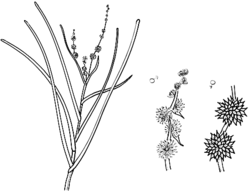Common name: Floating Bur-reed
Sparganium subglobosum Morong APNI* Synonyms: Sparganium antipodum Graebn. APNI*

Description: Emergent monoecious aquatic perennial to 1 m high.
Leaves emergent, erect, occasionally floating, to 1 m long and 8 mm wide, mostly basal, but progressively smaller leaves produced up the stem grading into the leaf-like inflorescence bracts.
Inflorescence with 0-few alternate branches, the lowest to 15 cm long, becoming progressively shorter upwards, always shorter than the main axis. Inflorescence bracts produced at the base of each branch or, where there are no branches, at the base of each female cluster; each branch with 2–20 dense globose clusters of unisexual flowers; female clusters 10–20 mm diam., male c. 10 mm diam. Perianth segments 3–6, c. 2 mm long, broadest near the apex, acute to obtuse. Anthers 0.5–1 mm long. Individual fruit 4–7 mm long, ± angled, with persistent style.
Flowering: during warmer months.
Distribution and occurrence: Grows in still or slow-flowing fresh water to c. 50 cm deep.
NSW subdivisions: NC, CC, SC, NT, CT, ST, SWS
Other Australian states: Qld Vic.
Text by S. W. L. Jacobs
Taxon concept: Flora of NSW 4 (1993)
APNI* Provides a link to the Australian Plant Name Index (hosted by the Australian National Botanic Gardens) for comprehensive bibliographic data
***The AVH map option provides a detailed interactive Australia wide distribution map drawn from collections held by all major Australian herbaria participating in the Australian Virtual Herbarium project.
|


